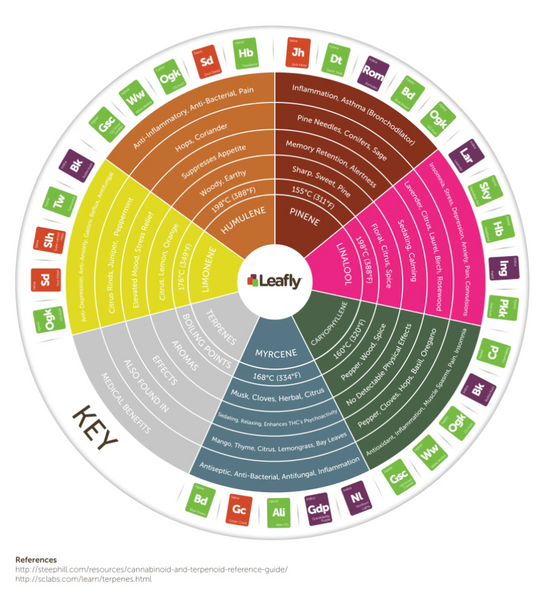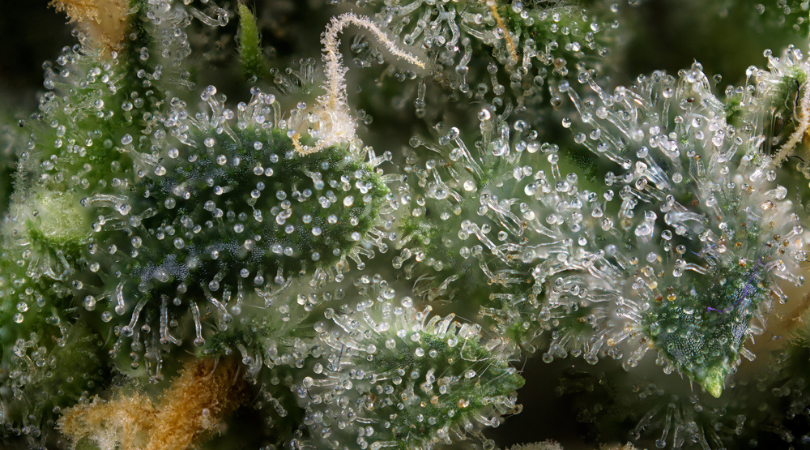
What are terpenes? In this terpene guide we will explain the significance of the terpene chart and various terpene effects.
Cannabis is sought-after for many reasons- while some users enjoy the physically relaxing and mentally uplifting effects of cannabis for recreational purposes, others enjoy the medical perks it can give, such as helping to counteract pain or help you sleep. While these terpene effects are often attributed to cannabinoids such as THC, the terpenes in cannabis also have a significant impact on the kind of terpene effects you experience.
Terpenes are naturally occurring organic compounds that can be found in many types of plants. For instance, flowers, fruits, and herbs are often packed with terpenes. Not only do terpenes impact the aroma and taste of various plants, but they can also have fascinating terpene effects on the body when consumed. This is particularly notable with cannabis as terpenes work in conjunction with cannabinoids to provide entourage effects.
When terpenes and cannabinoids work together, the recreational and medical effects of various cannabis strains are enhanced. For instance, some terpenes help with alleviating pain and inflammation whereas others are good for mental issues such as anxiety and stress. Of course, they’re also responsible for the unique aroma and taste of each strain.
Learning about the terpene chart can better help you understand the various terpene effects.

Hundreds of types of terpenes can be found in cannabis strains, but there are a few that are particularly common. Here are some of the most common cannabis terpenes explained.
What Are Terpenes?
Most people think of chemical compounds such as THC and CBD when they think of cannabis. However, cannabis strains also contain a wide range of other components that can also contribute to their unique effects. For instance, every cannabis strain contains a range of terpenes.
Terpenes or terpenoids are naturally occurring aromatic compounds that are found in all kinds of plants. For instance, flowers, fruits, and vegetables often get their unique aromas due to the terpenes they contain. This also applies to cannabis strains, hence why each strain smells different and tastes different when you smoke or vape it.
For example, some strains are high in Limonene- a terpene that’s also found in lemons and other citrus fruits. As such, these strains usually have a citrusy kick when you smoke them. Others are higher in earthy or floral terpenes, and these will have a different taste altogether. Each strain contains a host of different terpenes, although some are more dominant than others.
Terpenes don’t just make each strain taste and smell different. They can also work in conjunction with cannabinoids to contribute to the effects you’ll experience. For instance, some terpenes will add to the relaxing effects of cannabis whereas others can provide mentally uplifting effects. As such, it’s particularly interesting to look into the different terpenes found in cannabis and what exactly they can offer.
Types of Terpenes & Terpene Effects:

Myrcene
Myrcene is the most common terpene found in commercial strains of cannabis. That means that if you’re buying cannabis from a store or dispensary, you’re likely to find plenty of Myrcene-dominant strains. Some popular examples of strains high in Myrcene include OG Kush, Purple Urkle, and Pink Kush.
It’s characterized by its earthy yet spicy aroma- which makes sense as it’s also found in herbs such as hops, thyme, and parsley. It’s also found in citrus fruits such as mangoes, which explains why it often has a citrusy kick.
Myrcene is said to help increase THC absorption, meaning it can enhance the psychotropic effects of cannabis. Research also suggests that Myrcene can help with relaxation and promote the calming effects of various strains. This is especially helpful for those who use cannabis to relieve pain, hypertension, and stress.
Limonene
Another one of the most common terpenes that can be found in cannabis is Limonene. As you might deduce from the name, Limonene is a citrusy terpene that can also be found in lemons, oranges, and other citrus fruits. It’s also common in zesty strains such as Jack Herer, Sour Diesel, and Super Lemon Haze.
Limonene adds a sour and fruity kick to cannabis strains. It’s also said to have many perks, especially when it works in conjunction with cannabinoids. For instance, studies suggest Limonene has analgesic effects, antibacterial properties, and may even help reduce anxiety.
Due to its fruity taste and uplifting properties, Limonene is a welcome addition to many strains. It’s particularly common in sativa strains, which may explain why these are often recommended for tackling issues such as anxiety and stress.
Pinene
If you find that your cannabis has an earthy, pine-like scent, it likely contains a high amount of Pinene. Pinene is a terpene that can be found in pine trees, rosemary, basil, and other plants, as well as various strains of cannabis. Strains like Romulan, OG Kush, and Blue Dream are high in Pinene.
Pinene is said to help with alertness and memory, meaning it can often counteract some of the unwanted effects of THC. It can also act as a natural bronchodilator, meaning it can help improve breathing- especially for those suffering from asthma or other breathing issues.
Although Myrcene is the most common terpene found in cannabis strains, Pinene is the most common terpene found in plants overall and is also abundant in cannabis. Strains high in Pinene are perfect for those who want to experience the effects of THC without feeling too hazy-minded.

Beta-Caryophyllene
Sometimes referred to simply as Caryophyllene, Beta-Caryophyllene is another common terpene that’s found in cloves, cinnamon, and black pepper as well as many strains of cannabis. Caryophyllene adds a spicy kick to strains, with some popular examples including Bubba Kush, Rockstar, and Skywalker OG.
Interestingly, Beta-Caryophyllene is the only terpene that also acts as a cannabinoid. That means that, when consumed, Beta-Caryophyllene can interact with the body’s endocannabinoid system and provide anti-inflammatory effects.
Other potential perks of Beta-Caryophyllene have also been identified. For example, it’s said to have anticancer, antioxidant, and antimicrobial properties. Overall, it’s one of the most interesting terpenes found in cannabis plants.
Humulene
Humulene is a terpene with a herbal aroma, which makes sense as it can also be found in sage, ginseng, and hops. Interestingly, the name humulene comes from the Latin term for hops (Humulus Lupulus). Cannabis strains with high levels of humulene usually taste somewhat earthy and woody and may even remind you of the taste of beer.
Aside from its earthy and herbal flavor, Humulene is known for complementing the anti-inflammatory properties of properties. Not only that, but research also suggests that humulene may help fight tumors. As such, cannabis strains with high levels of Humulene are usually soothing, relieving, and ideal for medical marijuana users.
Popular examples of cannabis strains that are high in Humulene include Pink Kush, Sour Diesel, and Girl Scout Cookies. It’s one of the most common terpenes found in cannabis and can contribute to the physically relieving effects of cannabis strains on top of adding to the flavor.
Borneol
Borneol is a terpene that can be found in plants such as mugwort, rosemary, and mint. Interestingly, Borneol is also known as a traditional Chinese medicine that has long been used to help with various issues. It’s also known as a potent insect repellent, making it particularly helpful for various cannabis strains.
The properties of Borneol are said to help with relaxation, circulation, digestive issues, stress, and anxiety. As such, it works particularly well in conjunction with cannabinoids like THC when it comes to relieving a range of physical and mental issues. Strains that are high in Borneol will usually be more relaxing and soothing.
Borneol has a bitter and somewhat acidic taste. Strains that are high in Borneol may taste herbal and slightly minty. Although it’s not one of the most common terpenes found in cannabis strains, it’s common in Haze strains.

Terpinolene
Terpinolene is another one of the lesser-known terpenes found in cannabis. Around one in ten strains are Terpinolene dominant, but this terpene is said to be particularly uplifting and can also contribute to the aroma and taste of a strain significantly.
This terpene has a somewhat interesting scent and taste. It’s floral yet piney and herbal at the same time. It can be found in lilac, nutmeg, cumin, and even apples. Of course, it can also be found in a range of cannabis strains. Strains that are high in Terpinolene will usually have a floral scent and taste.
Terpinolene is mainly known for adding to the uplifting effects of cannabis. It can boost your mood and heighten your senses. It’s also said to have antioxidant, antibacterial, anti-fungal, and even anti-cancer properties. Some of the strains that are high in terpinolene include Ghost Train Haze, Jack Herer, and Chernobyl.
Linalool
Another cannabis terpene you might not have heard much about is Linalool. Although it’s not as common as terpenes like Limonene or Myrcene, Linalool can add a lot to a strain. Linalool is said to have calming and relaxing effects, meaning it works particularly well in conjunction with the physically soothing effects of THC.
While some terpenes are fruity and others are piney and earthy, Linalool has an enjoyable floral aroma and scent. This makes sense as it can also be found in lavender plants as well as jasmine, rosewood, basil, and thyme.
As well as promoting relaxation, Linalool is said to help with anxiety, depression, pain, insomnia, and inflammation. Linalool is a relatively rare cannabis terpene, although it can be found in strains such as Zkittlez, Chem Dawg, and Lavender.
Eucalyptol
Eucalyptol (also known as Cineole) is a fresh and minty terpene that’s known for being the dominant terpene in eucalyptus trees. It can also be found in bay leaves, rosemary, sage, tea tree, and cardamom, as well as a range of cannabis strains. Although it’s not particularly common in cannabis, it adds a lot of flavor to certain strains.
As you might guess, Eucalyptol has a refreshingly cool, minty flavor, much like eucalyptus. It’s often found in products such as mouthwash and toothpaste because of this. Cannabis strains that contain eucalyptol will often have a menthol kick and it can also contribute to the effects of these strains.
Eucalyptol is said to have analgesic, antifungal, and antibacterial effects. Some research suggests it may even help with Alzheimer’s. It can also help with blood circulation, making it useful for a range of issues. Some examples of cannabis strains that contain Eucalyptol include Super Silver Haze and Girl Scout Cookies.

Camphene
Camphene is another terpene that can be found in cannabis. It has a pungent, musky odor that may remind you of fir needles and damp wood or earth. Due to its dank and earthy aroma, it’s often compared to Myrcene.
Beyond its aroma, Camphene can contribute a lot to cannabis strains. Research suggests that Camphene is a potent antioxidant and may also help to reduce levels of cholesterol and triglycerides in the blood, making it useful for a range of cardiovascular issues.
While it’s not as prevalent in cannabis as terpenes such as Myrcene and Limonene, it can still be found in a range of strains. Some examples of cannabis strains that contain Camphene include Ghost OG, Strawberry Banana, and Mendocino Purps.
How To Experience Cannabis Terpenes
Each cannabis strain has a unique profile of terpenes and these contribute to the strain in many ways. For instance, the aroma of your weed comes down to the terpenes it contains. They also impact the taste you’ll experience when you smoke your weed.
The method you use to consume cannabis can make a significant difference. For instance, while you’ll still experience much of the terpenoid profile of your cannabis when you smoke a joint, using a Glass Pipe or Bong will bring out more of the flavor.
Alternatively, you may want to use a Vape Pen or Vaporizer. These allow you to adjust the temperature to bring out as much or as little of the flavor of your weed as you want. Vaping at lower temperatures will generally bring out more of the terpenes whereas vaping at higher temperatures will help release more cannabinoids.
Terpenes & Terpene Chart Conclusion
From Myrcene to Camphene, terpenes can contribute a lot to the aroma, taste, and effects of each cannabis strain. While these are some of the most common cannabis terpenes, there are also many others such as Phytol, Sabinene, Terpineol, and Ocimene.
After reading this extensive terpene guide, you should now have a better understanding of terpenes, their terpene effects, and how to read a terpene chart.
You’ll experience the terpenoid profile of your cannabis every time you smoke it. However, if you want to make your smoking sessions as enjoyable and flavorful as possible, you might want to upgrade from a joint to a Glass Pipe, Bong, Bubbler, or Vaporizer. You can find all of these accessories and more at Fat Buddha Glass.





